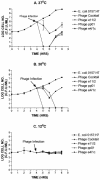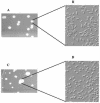Evaluation of a cocktail of three bacteriophages for biocontrol of Escherichia coli O157:H7
- PMID: 15184139
- PMCID: PMC427753
- DOI: 10.1128/AEM.70.6.3417-3424.2004
Evaluation of a cocktail of three bacteriophages for biocontrol of Escherichia coli O157:H7
Abstract
Escherichia coli O157:H7 is an endemic pathogen causing a variety of human diseases including mild diarrhea, hemorrhagic colitis, hemolytic-uremic syndrome, and thrombotic thrombocytopenic purpura. This study concerns the exploitation of bacteriophages as biocontrol agents to eliminate the pathogen E. coli O157:H7. Two distinct lytic phages (e11/2 and e4/1c) isolated against a human strain of E. coli O157:H7, a previously isolated lytic phage (pp01), and a cocktail of all three phages were evaluated for their ability to lyse the bacterium in vivo and in vitro. Phage e11/2, pp01, and the cocktail of all three virulent phages resulted in a 5-log-unit reduction of pathogen numbers in 1 h at 37 degrees C. However, bacteriophage-insensitive mutants (BIMs) emerged following the challenge. All tested BIMs had a growth rate which approximated that of the parental O157 strain, although many of these BIMs had a smaller, more coccoid cellular morphology. The frequency of BIM formation (10(-6) CFU) was similar for e11/2, pp01, and the phage cocktail, while BIMs insensitive to e4/1c occurred at the higher frequency (10(-4) CFU). In addition, BIMs commonly reverted to phage sensitivity within 50 generations. In an initial meat trial experiment, the phage cocktail completely eliminated E. coli O157:H7 from the beef meat surface in seven of nine cases. Given that the frequency of BIM formation is low (10(-6) CFU) for two of the phages, allied to the propensity of these mutants to revert to phage sensitivity, we expect that BIM formation should not hinder the use of these phages as biocontrol agents, particularly since low levels of the pathogen are typically encountered in the environment.
Figures



References
-
- Barrow, P. 2001. The use of bacteriophages for treatment and prevention of bacterial disease in animals and animal models of human infection. J. Chem. Technol. Biotechnol. 76:677-682.
-
- Berchieri, A., Jr., M. A. Lovell, and P. A. Barrow. 1991. The activity in the chicken alimentary tract of bacteriophages lytic for Salmonella typhimurium. Res. Microbiol. 142:541-549. - PubMed
-
- Cagney, C., H. Crowley, G. Duffy, J. J. Sheridan, S. O’Brien, E. Carney, W. A. Anderson, D. A. McDowell, and I. S. Blair. 2004. Prevalence and numbers of Escherichia coli O157:H7 in minced beef and beef burgers from butcher shops and supermarkets in the Republic of Ireland. Food Microbiol. 21:203-212.
Publication types
MeSH terms
LinkOut - more resources
Full Text Sources
Other Literature Sources
Molecular Biology Databases

